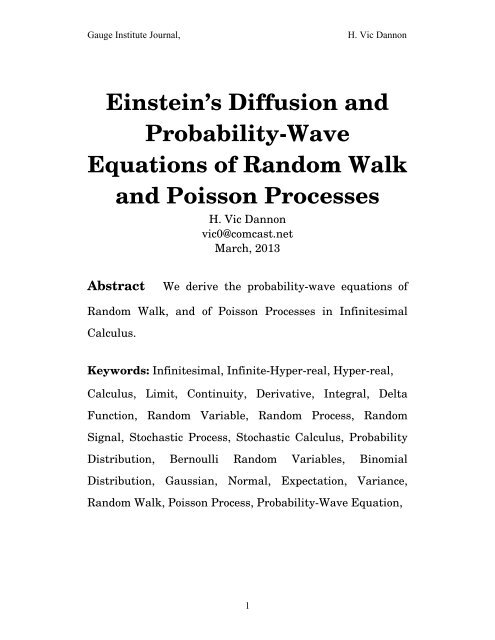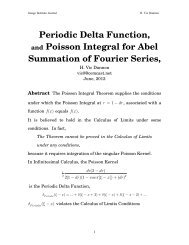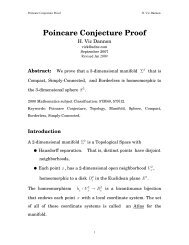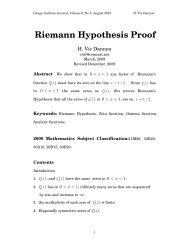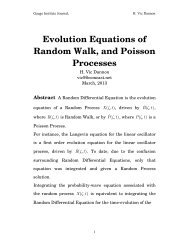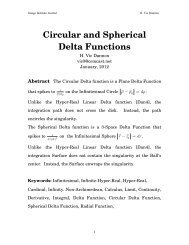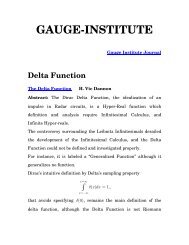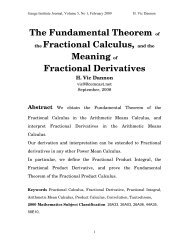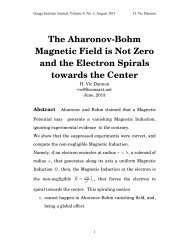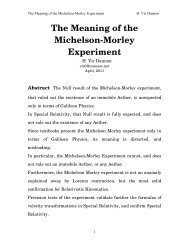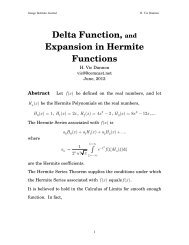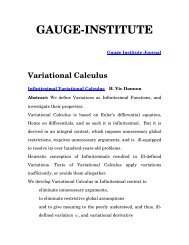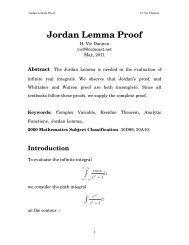Einstein's Diffusion and Probability-Wave Equations of Random ...
Einstein's Diffusion and Probability-Wave Equations of Random ...
Einstein's Diffusion and Probability-Wave Equations of Random ...
You also want an ePaper? Increase the reach of your titles
YUMPU automatically turns print PDFs into web optimized ePapers that Google loves.
Gauge Institute Journal,<br />
H. Vic Dannon<br />
Einstein’s <strong>Diffusion</strong> <strong>and</strong><br />
<strong>Probability</strong>-<strong>Wave</strong><br />
<strong>Equations</strong> <strong>of</strong> R<strong>and</strong>om Walk<br />
<strong>and</strong> Poisson Processes<br />
H. Vic Dannon<br />
vic0@comcast.net<br />
March, 2013<br />
Abstract<br />
We derive the probability-wave equations <strong>of</strong><br />
R<strong>and</strong>om Walk, <strong>and</strong> <strong>of</strong> Poisson Processes in Infinitesimal<br />
Calculus.<br />
Keywords: Infinitesimal, Infinite-Hyper-real, Hyper-real,<br />
Calculus, Limit, Continuity, Derivative, Integral, Delta<br />
Function, R<strong>and</strong>om Variable, R<strong>and</strong>om Process, R<strong>and</strong>om<br />
Signal, Stochastic Process, Stochastic Calculus, <strong>Probability</strong><br />
Distribution, Bernoulli R<strong>and</strong>om Variables, Binomial<br />
Distribution, Gaussian, Normal, Expectation, Variance,<br />
R<strong>and</strong>om Walk, Poisson Process, <strong>Probability</strong>-<strong>Wave</strong> Equation,<br />
1
Gauge Institute Journal,<br />
H. Vic Dannon<br />
2000 Mathematics Subject Classification 26E35; 26E30;<br />
26E15; 26E20; 26A06; 26A12; 03E10; 03E55; 03E17; 03H15;<br />
46S20; 97I40; 97I30.<br />
Contents<br />
Einstein’s Derivation <strong>of</strong> the <strong>Diffusion</strong> Equation<br />
1. Hyper-real Line<br />
2. Hyper-real Function<br />
3. Integral <strong>of</strong> a Hyper-real Function<br />
4. Delta Function<br />
5. <strong>Probability</strong>-<strong>Wave</strong> Equation <strong>of</strong> R<strong>and</strong>om Walk<br />
6. <strong>Probability</strong>-<strong>Wave</strong> Equation <strong>of</strong> Poisson Process<br />
References<br />
2
Gauge Institute Journal,<br />
H. Vic Dannon<br />
0.<br />
Einstein’s Derivation <strong>of</strong> the<br />
<strong>Diffusion</strong> Equation<br />
0.1 Einstein’s Assumptions for Brownian Motion<br />
In 1905, Einstein analyzed the Brownian Motion.<br />
In [Einstein, p.130], he assumed the following<br />
1) Each particle moves independently <strong>of</strong> the other particles<br />
2) The motions <strong>of</strong> a particle over different, not-infinitesimal,<br />
time intervals, are mutually independent<br />
3) τ is a small but non-infinitesimal time interval so that<br />
motions are mutually independent<br />
4) n is the number <strong>of</strong> particles<br />
5) Over the time τ , a particle moves from x to x +Δ, where<br />
Δ depends on the particle, <strong>and</strong> may be positive or negative<br />
6) the number <strong>of</strong> particles displaced from Δ , to Δ+ dΔ,<br />
over the time<br />
where<br />
τ<br />
is<br />
dn = nϕ( Δ)<br />
dΔ,<br />
3
Gauge Institute Journal,<br />
H. Vic Dannon<br />
Δ=∞<br />
∫<br />
Δ=−∞<br />
ϕ( Δ) dΔ = 1,<br />
ϕ( Δ) ≠ 0, only for very small Δ ,<br />
ϕ( Δ ) = ϕ( −Δ).<br />
7) f (,) xt is the particles’ density at x , at time t<br />
We first note that<br />
ϕ( Δ ) is the Delta Function that was established already in<br />
1882 by Kirchh<strong>of</strong>f. [Temple, p.158], <strong>and</strong> was similarly<br />
presented without mentioning Kirchh<strong>of</strong>f by Dirac.<br />
Recently, we established the Delta Function as a hyper-real<br />
function in infinitesimal Calculus. [Dan4]. Then,<br />
δ( x)<br />
⎧ 1<br />
dx dx<br />
, x ∈ ⎡−<br />
, ⎤<br />
= ⎪ dx ⎢ 2 2 ⎥<br />
⎨ ⎣ ⎦<br />
⎪⎪ 0, otherwise<br />
⎩<br />
Consequently, according to assumption 6<br />
dn = nδ( Δ)<br />
dΔ<br />
⎧ 1<br />
dΔ<br />
dΔ<br />
dΔ, Δ ∈ ⎡−<br />
, ⎤<br />
= n ⎪ dΔ<br />
⎢ 2 2 ⎥<br />
⎨ ⎣ ⎦<br />
⎪⎪ 0, otherwise<br />
⎩<br />
⎧ dΔ dΔ<br />
n, Δ∈⎡−<br />
, ⎤<br />
= ⎪ ⎢ 2 2 ⎥<br />
⎨ ⎣ ⎦<br />
⎪⎪ 0, otherwise<br />
⎩<br />
4
Gauge Institute Journal,<br />
H. Vic Dannon<br />
That is, all the particles are in an infinitesimal interval at<br />
the origin…<br />
This bizarre conclusion leads to no contradiction since<br />
neither<br />
n , nor dn , appear in the following Einstein’s<br />
derivation…<br />
0.2 Einstein’s Derivation <strong>of</strong> the <strong>Diffusion</strong> Equation<br />
Einstein starts with equation (17), p.131, claiming that<br />
Δ=∞<br />
∫<br />
f (, xt+ τ) = fx ( + Δ,)( tδ<br />
Δ)<br />
dΔ<br />
Δ=−∞<br />
In fact, the sifting by<br />
δ( Δ ) gives f (,) xt , <strong>and</strong> no equality.<br />
Einstein’s next claim<br />
m<strong>and</strong>ates that<br />
τ<br />
f<br />
fxt (, + τ) = fxt (,) + τ ∂ , ∂ t<br />
must be an infinitesimal.<br />
This makes assumptions 2, <strong>and</strong> 3, meaningless, but leads to<br />
no contradiction, since the assumptions are not used in the<br />
derivation that follows…<br />
Then, Einstein’s exp<strong>and</strong>s his integr<strong>and</strong><br />
∂fxt<br />
(,) 1 ∂ fxt (,) 2<br />
fx ( +Δ , t) = fxt ( , ) + Δ+ Δ + ...<br />
∂x<br />
2! 2<br />
∂x<br />
2<br />
5
Gauge Institute Journal,<br />
H. Vic Dannon<br />
<strong>and</strong> writes his integral as<br />
Δ=∞ Δ=∞ 2<br />
Δ=∞<br />
f<br />
1 f<br />
2<br />
fxt (,) δ ∂<br />
( ) d ( ) d ( ) d ..<br />
x<br />
δ ∂<br />
∫ Δ Δ + Δ Δ Δ + Δ<br />
2!<br />
δ Δ Δ +<br />
∂<br />
∫ ∫<br />
2<br />
∂x<br />
Δ=−∞ Δ=−∞ Δ=−∞<br />
He observes that the odd integrals vanish<br />
Δ=∞<br />
∫ Δδ( Δ) dΔ = 0,<br />
Δ=−∞<br />
Δ=∞<br />
∫<br />
Δ=−∞<br />
Δ 3 δ( Δ) dΔ = 0<br />
………………………<br />
He only misses that the even integrals vanish as well.<br />
Indeed, the sifting by<br />
δ( Δ)<br />
, gives<br />
k<br />
Δ = 0 .<br />
Δ= 0<br />
In particular, his Drift Coefficient, which is [p.131]<br />
D<br />
Δ=∞<br />
∫<br />
2ϕ( ) dΔ,<br />
Δ=−∞<br />
1<br />
= Δ Δ<br />
2τ<br />
vanishes,<br />
<strong>and</strong> his <strong>Diffusion</strong> Equation [equation 18, p. 132]<br />
collapses to<br />
2<br />
∂f<br />
∂ f<br />
= D<br />
∂t<br />
2<br />
∂x<br />
∂ f =<br />
∂t<br />
0 .<br />
,<br />
6
Gauge Institute Journal,<br />
H. Vic Dannon<br />
0.3 Probabilistic <strong>Wave</strong> <strong>Equations</strong><br />
The diffusion equation is an equation for a probability wave.<br />
As such it can be derived by probabilistic considerations.<br />
Here, we use these considerations in infinitesimal calculus to<br />
drive the diffusion equation for the R<strong>and</strong>om drift <strong>of</strong> a<br />
particle in fluid due to collisions with fluid molecules.<br />
And the probability-wave equation for the Poisson Process<br />
that models the R<strong>and</strong>om arrival <strong>of</strong> radioactive particles at a<br />
counter.<br />
7
Gauge Institute Journal,<br />
H. Vic Dannon<br />
1.<br />
Hyper-real Line<br />
The minimal domain <strong>and</strong> range, needed for the definition<br />
<strong>and</strong> analysis <strong>of</strong> a hyper-real function, is the hyper-real line.<br />
Each real number α can be represented by a Cauchy<br />
sequence <strong>of</strong> rational numbers, ( r , r , r ,...) so that r → α .<br />
1 2 3<br />
The constant sequence ( ααα , , ,...) is a constant hyper-real.<br />
In [Dan2] we established that,<br />
1. Any totally ordered set <strong>of</strong> positive, monotonically<br />
n<br />
decreasing to zero sequences<br />
family <strong>of</strong> infinitesimal hyper-reals.<br />
( ι1, ι2, ι3,...)<br />
constitutes a<br />
2. The infinitesimals are smaller than any real number,<br />
yet strictly greater than zero.<br />
1 1 1<br />
3. Their reciprocals ( , , ,...<br />
ι 1<br />
ι 2<br />
ι 3<br />
) are the infinite hyperreals.<br />
4. The infinite hyper-reals are greater than any real<br />
number, yet strictly smaller than infinity.<br />
8
Gauge Institute Journal,<br />
H. Vic Dannon<br />
5. The infinite hyper-reals with negative signs are<br />
smaller than any real number, yet strictly greater than<br />
−∞.<br />
6. The sum <strong>of</strong> a real number with an infinitesimal is a<br />
non-constant hyper-real.<br />
7. The Hyper-reals are the totality <strong>of</strong> constant hyperreals,<br />
a family <strong>of</strong> infinitesimals, a family <strong>of</strong><br />
infinitesimals with negative sign, a family <strong>of</strong> infinite<br />
hyper-reals, a family <strong>of</strong> infinite hyper-reals with<br />
negative sign, <strong>and</strong> non-constant hyper-reals.<br />
8. The hyper-reals are totally ordered, <strong>and</strong> aligned along<br />
a line: the Hyper-real Line.<br />
9. That line includes the real numbers separated by the<br />
non-constant hyper-reals. Each real number is the<br />
center <strong>of</strong> an interval <strong>of</strong> hyper-reals, that includes no<br />
other real number.<br />
10. In particular, zero is separated from any positive<br />
real by the infinitesimals, <strong>and</strong> from any negative real<br />
by the infinitesimals with negative signs, −dx .<br />
11. Zero is not an infinitesimal, because zero is not<br />
strictly greater than zero.<br />
9
Gauge Institute Journal,<br />
H. Vic Dannon<br />
12. We do not add infinity to the hyper-real line.<br />
13. The infinitesimals, the infinitesimals with<br />
negative signs, the infinite hyper-reals, <strong>and</strong> the infinite<br />
hyper-reals with negative signs are semi-groups with<br />
respect to addition. Neither set includes zero.<br />
∞<br />
14. The hyper-real line is embedded in , <strong>and</strong> is<br />
not homeomorphic to the real line. There is no bicontinuous<br />
one-one mapping from the hyper-real onto<br />
the real line.<br />
15. In particular, there are no points on the real line<br />
that can be assigned uniquely to the infinitesimal<br />
hyper-reals, or to the infinite hyper-reals, or to the nonconstant<br />
hyper-reals.<br />
16. No neighbourhood <strong>of</strong> a hyper-real is<br />
n<br />
homeomorphic to an ball. Therefore, the hyperreal<br />
line is not a manifold.<br />
17. The hyper-real line is totally ordered like a line,<br />
but it is not spanned by one element, <strong>and</strong> it is not onedimensional.<br />
10
Gauge Institute Journal,<br />
H. Vic Dannon<br />
2.<br />
Hyper-real Function<br />
2.1 Definition <strong>of</strong> a hyper-real function<br />
f () x is a hyper-real function, iff it is from the hyper-reals<br />
into the hyper-reals.<br />
This means that any number in the domain, or in the range<br />
<strong>of</strong> a hyper-real f () x is either one <strong>of</strong> the following<br />
real<br />
real + infinitesimal<br />
real – infinitesimal<br />
infinitesimal<br />
infinitesimal with negative sign<br />
infinite hyper-real<br />
infinite hyper-real with negative sign<br />
Clearly,<br />
2.2 Every function from the reals into the reals is a hyperreal<br />
function.<br />
11
Gauge Institute Journal,<br />
H. Vic Dannon<br />
3.<br />
Integral <strong>of</strong> Hyper-real Function<br />
In [Dan3], we defined the integral <strong>of</strong> a Hyper-real Function.<br />
Let f () x be a hyper-real function on the interval [ ab] , .<br />
The interval may not be bounded.<br />
f () x may take infinite hyper-real values, <strong>and</strong> need not be<br />
bounded.<br />
At each<br />
a<br />
≤<br />
x<br />
≤b,<br />
there is a rectangle with base<br />
dx<br />
[ x − , x + 2<br />
], height f () x ,<br />
dx<br />
2<br />
<strong>and</strong> area<br />
f ( xdx. )<br />
We form the Integration Sum <strong>of</strong> all the areas for the x ’s<br />
that start at x = a, <strong>and</strong> end at x = b,<br />
∑ f ( xdx ) .<br />
x∈[ a, b]<br />
If for any infinitesimal dx , the Integration Sum has the<br />
same hyper-real value, then f () x is integrable over the<br />
interval [ ab] , .<br />
12
Gauge Institute Journal,<br />
H. Vic Dannon<br />
Then, we call the Integration Sum the integral <strong>of</strong> f () x from<br />
x = a, to x = b, <strong>and</strong> denote it by<br />
x=<br />
b<br />
∫ f ( xdx ) .<br />
x=<br />
a<br />
If the hyper-real is infinite, then it is the integral over [, ab] ,<br />
If the hyper-real is finite,<br />
x=<br />
b<br />
∫ fxdx ( ) = real part <strong>of</strong> the hyper-real . <br />
x=<br />
a<br />
3.1 The countability <strong>of</strong> the Integration Sum<br />
In [Dan1], we established the equality <strong>of</strong> all positive<br />
infinities:<br />
We proved that the number <strong>of</strong> the Natural Numbers,<br />
Card , equals the number <strong>of</strong> Real Numbers,<br />
2 Card <br />
Card = , <strong>and</strong> we have<br />
2 Card<br />
2<br />
Card <br />
Card = ( Card) = .... = 2 = 2 = ... ≡ ∞.<br />
In particular, we demonstrated that the real numbers may<br />
be well-ordered.<br />
13
Gauge Institute Journal,<br />
H. Vic Dannon<br />
Consequently, there are countably many real numbers in the<br />
interval<br />
[,] ab<br />
, <strong>and</strong> the Integration Sum has countably many<br />
terms.<br />
While we do not sequence the real numbers in the interval,<br />
the summation takes place over countably many f ( xdx. )<br />
The Lower Integral is the Integration Sum where f ( x ) is<br />
replaced<br />
by its lowest value on each interval<br />
3.2<br />
∑<br />
x∈[ a, b]<br />
⎛<br />
⎜⎝<br />
dx dx<br />
2 2<br />
[ x − , x + ]<br />
⎞<br />
inf f ( t)<br />
dx<br />
⎠⎟<br />
x− ≤t≤ x+<br />
dx dx<br />
2 2<br />
The Upper Integral is the Integration Sum where f ( x ) is<br />
replaced by its largest value on each interval<br />
3.3<br />
∑<br />
x∈[ a, b]<br />
⎛<br />
⎜⎝<br />
⎞ sup f ( t)<br />
dx<br />
⎠⎟<br />
dx dx<br />
2 2<br />
x− ≤t≤ x+<br />
[ x − , x + ]<br />
dx dx<br />
2 2<br />
If the integral is a finite hyper-real, we have<br />
14
Gauge Institute Journal,<br />
H. Vic Dannon<br />
3.4 A hyper-real function has a finite integral if <strong>and</strong> only if<br />
its upper integral <strong>and</strong> its lower integral are finite, <strong>and</strong> differ<br />
by an infinitesimal.<br />
15
Gauge Institute Journal,<br />
H. Vic Dannon<br />
4.<br />
Delta Function<br />
In [Dan4], we defined the Delta Function, <strong>and</strong> established its<br />
properties<br />
1. The Delta Function is a hyper-real function defined<br />
from the hyper-real line into the set <strong>of</strong> two hyper-reals<br />
⎧<br />
⎪ 1 ⎫<br />
⎨0, ⎪<br />
⎬. The hyper-real 0 is the sequence 0, 0, 0,... .<br />
⎪⎩<br />
dx ⎪ ⎭<br />
The infinite hyper-real 1<br />
dx<br />
depends on our choice <strong>of</strong><br />
dx .<br />
2. We will usually choose the family <strong>of</strong> infinitesimals that<br />
is spanned by the sequences<br />
1<br />
n , 1<br />
2<br />
n<br />
,<br />
1<br />
n<br />
3<br />
,… It is a<br />
semigroup with respect to vector addition, <strong>and</strong> includes<br />
all the scalar multiples <strong>of</strong> the generating sequences<br />
that are non-zero. That is, the family includes<br />
infinitesimals with negative sign. Therefore,<br />
1<br />
dx<br />
will<br />
mean the sequence n . Alternatively, we may choose<br />
16
Gauge Institute Journal,<br />
H. Vic Dannon<br />
the family spanned by the sequences<br />
1<br />
2 n ,<br />
1<br />
3 n ,<br />
1<br />
4 n ,… Then, 1<br />
dx<br />
will mean the sequence<br />
2 n . Once we determined the basic infinitesimal dx ,<br />
we will use it in the Infinite Riemann Sum that defines<br />
an Integral in Infinitesimal Calculus.<br />
3. The Delta Function is strictly smaller than ∞<br />
4. We define,<br />
1<br />
χ δ ( x) ≡ dx ( )<br />
,<br />
dx x<br />
dx<br />
⎡ ⎤ ,<br />
⎢−<br />
⎣ 2 2 ⎥⎦<br />
where<br />
χ ⎡<br />
⎢−<br />
⎣<br />
dx,<br />
dx<br />
2 2<br />
⎧ dx dx<br />
1, x ∈ ⎡−<br />
, ⎤<br />
( x)<br />
= ⎢ 2 2 ⎥<br />
⎨ ⎪ ⎣ ⎦ .<br />
⎪⎪ 0, otherwise<br />
⎩<br />
⎤<br />
⎥⎦<br />
5. Hence,<br />
for x < 0 , δ ( x) = 0<br />
at<br />
for<br />
dx<br />
x =− , δ( x)<br />
jumps from 0 to<br />
2<br />
dx dx<br />
⎢ ⎣<br />
,<br />
2 2 ⎥ ⎦ , 1<br />
( x)<br />
x ∈ ⎡−<br />
⎤<br />
δ = .<br />
dx<br />
1<br />
dx ,<br />
at x = 0 ,<br />
δ (0) =<br />
1<br />
dx<br />
at<br />
dx<br />
x = , δ( x)<br />
drops from<br />
2<br />
for x > 0 , δ ( x) = 0.<br />
1<br />
dx<br />
to 0.<br />
17
Gauge Institute Journal,<br />
H. Vic Dannon<br />
xδ ( x) = 0<br />
6. If dx =<br />
1<br />
, ( x) = 1 1( x),2 1 1( x),3 1 1( x )...<br />
n<br />
[ − , ] [ − , ] [ − , ]<br />
δ χ χ χ<br />
2 2 4 4 6 6<br />
7. If dx =<br />
2<br />
,<br />
n<br />
8. If dx =<br />
1<br />
,<br />
n<br />
1 2 3<br />
δ ( x) = , , ,...<br />
2 2 2<br />
2 cosh x 2 cosh 2x 2 cosh 3x<br />
−x −2x −3x<br />
[0, ∞) [0, ∞) [0, ∞)<br />
δ( x) = e χ ,2 e χ , 3 e χ ,...<br />
x =∞<br />
∫<br />
9. δ( xdx ) = 1.<br />
x =−∞<br />
k =∞<br />
1 −ik( ξ−x<br />
)<br />
10. δξ ( − x)<br />
= e<br />
2π<br />
∫ dk<br />
k =−∞<br />
18
Gauge Institute Journal,<br />
H. Vic Dannon<br />
5.<br />
<strong>Probability</strong>-<strong>Wave</strong> Equation for<br />
R<strong>and</strong>om Walk<br />
The R<strong>and</strong>om Walk <strong>of</strong> small particles in fluid is named after<br />
Brown, who first observed it, Brownian Motion. It models<br />
other processes, such as the fluctuations <strong>of</strong> a stock price.<br />
In a volume <strong>of</strong> fluid, the path <strong>of</strong> a particle is in any direction<br />
in the volume, <strong>and</strong> <strong>of</strong> variable size<br />
5.1 Bernoulli R<strong>and</strong>om Variables <strong>of</strong> the Walk<br />
We restrict the Walk here to the line, in uniform<br />
infinitesimal size steps dx :<br />
To the left, with probability<br />
19
Gauge Institute Journal,<br />
H. Vic Dannon<br />
or to the right, with probability<br />
p ,<br />
q<br />
= 1 − p.<br />
At time t , after<br />
N infinitesimal time intervals dt ,<br />
N =<br />
t<br />
dt<br />
, is an infinite hyper-real,<br />
the particle is at the point<br />
x .<br />
At the i th step we define the Bernoulli R<strong>and</strong>om Variable,<br />
Bi (right step)<br />
Bi (left step)<br />
where i = 1,2,..., N .<br />
= dx , ζ<br />
1<br />
= right step .<br />
=−dx, ζ<br />
2<br />
= left step .<br />
Pr( B = dx)<br />
= p,<br />
i<br />
Pr( B =− dx)<br />
= q,<br />
i<br />
E[ B ] = dx ⋅ p + ( −dx ) ⋅ q = ( p − q)<br />
dx ,<br />
i<br />
2 2 2<br />
i<br />
EB [ ] = ( dx) ⋅ p+ ( −dx) ⋅ q = ( dx)<br />
2 2<br />
i i<br />
2<br />
( dx)<br />
( p−q)<br />
dx<br />
Var[ Bi] = E[ B ] −( E[ B ])<br />
<br />
= (1<br />
<br />
+ p −q)(1 − p + q)( dx) = 4 pq( dx)<br />
2p<br />
2 2<br />
q<br />
2<br />
20
Gauge Institute Journal,<br />
H. Vic Dannon<br />
5.2 The R<strong>and</strong>om Walk<br />
B ζ t = B + B + + B<br />
( , )<br />
1 2<br />
...<br />
N<br />
is a R<strong>and</strong>om Process with<br />
EB [ ( ζ , t)] = ( p− qNdx ) ,<br />
Var[ B( ζ , t)] = 4 pqN( dx) 2 .<br />
Pro<strong>of</strong>: Since the<br />
B i<br />
are independent,<br />
EB [ ( ζ, t)] = EB [ ] + ... + EB [ ] = ( p−qNdx<br />
)<br />
1 N<br />
( p−q) dx ( p−q)<br />
dx<br />
Var[ B( ζ , t)] = Var[ B ] + ... + Var[ B ] = 4 pqN( dx)<br />
<br />
1<br />
N<br />
2<br />
4 pq( dx )<br />
2<br />
4 pq( dx )<br />
2<br />
.<br />
5.3 The Focker-Planck <strong>Probability</strong>-<strong>Wave</strong> Equation <strong>of</strong><br />
the Walk<br />
Let (1) ( dx) = 2 D( dt)<br />
,<br />
2<br />
where the Drift Coefficient D is a constant,<br />
(2) ( p − q) dx = 2Cdt<br />
,<br />
where the Speed C is a constant<br />
(3)<br />
1 1<br />
Pr( x − dx ≤ B(,) ζ t ≤ x + dx) = f(,)<br />
x t dx<br />
2 2<br />
Then, the <strong>Probability</strong>-<strong>Wave</strong> Equation <strong>of</strong> B(,)<br />
ζ t for f (,) xt is<br />
infinitesimally close to the <strong>Diffusion</strong> Equation<br />
21
Gauge Institute Journal,<br />
H. Vic Dannon<br />
Pro<strong>of</strong>: We’ll denote<br />
2<br />
t<br />
2<br />
x<br />
( )<br />
x<br />
∂ f = − C∂ f + D ∂ f<br />
1 1<br />
( x − dx ≤ B ζ t ≤ x + dx) = ( B ζ t x)<br />
Pr ( , ) Pr ( , )<br />
2 2<br />
Then, by Bayes’ Theorem,<br />
( B ζ t dt x)<br />
Pr ( , + ) =<br />
<br />
f ( xt , + dtdx )<br />
( ) (<br />
= Pr B(, ζ t + dt) x / B(,) ζ t x −dx Pr B(,)<br />
ζ t x −dx<br />
+<br />
<br />
p f( x−dx, t)<br />
dx<br />
( ) (<br />
+ Pr B(, ζ t + dt) x / B(,) ζ t x + dx Pr B(,)<br />
ζ t x + dx<br />
<br />
That is,<br />
Substituting<br />
we obtain<br />
q<br />
f( x+<br />
dx, t)<br />
dx<br />
f (, x t + dt) = pf ( x − dx,) t + qf ( x + dx,)<br />
t .<br />
f (, x t + dt) ≈ f (,) x t + ( ∂ f (,)) x t dt ,<br />
t<br />
1<br />
2<br />
2 2<br />
x<br />
f ( x − dxt ,) ≈ fxt (,) − ( ∂ fxt (,)) dx + ( ∂ fxt (,))( dx)<br />
,<br />
x<br />
1 2 2<br />
x 2 x<br />
)<br />
f ( x+ dxt , ) ≈ fxt ( , ) + ( ∂ fxt ( , )) dx+ ( ∂ fxt ( , ))( dx ,<br />
1 2 2<br />
x<br />
2 x<br />
<br />
−2 Cdt<br />
( Ddt )<br />
( ∂t<br />
f ( xt , )) dt ≈ ( q − pdx ) ( ∂ fxt ( , )) + ( dx ) ( ∂ fxt ( , ))<br />
<br />
,<br />
)<br />
)<br />
22
Gauge Institute Journal,<br />
H. Vic Dannon<br />
2<br />
t x x<br />
∂ f (,) xt ≈ −2 C∂ fxt (,) + ( D) ∂ fxt (,),<br />
which is the <strong>Diffusion</strong> Equation.<br />
5.4<br />
fxt (.)<br />
=<br />
1<br />
e<br />
2 π (4 pq)2Dt<br />
2<br />
1( x−2 Ct)<br />
−<br />
2(4 pq)2Dt<br />
solves the <strong>Diffusion</strong> Equation,<br />
2<br />
t x x<br />
∂ f (,) xt = −2 C∂ fxt (,) + ( D) ∂ fxt (,).<br />
Pro<strong>of</strong>: By substitution. <br />
23
Gauge Institute Journal,<br />
H. Vic Dannon<br />
6.<br />
<strong>Probability</strong>-<strong>Wave</strong> Equation for<br />
Poisson Process<br />
The arrival at rate λ , <strong>of</strong> radioactive particles at a counter is<br />
modeled by the Poisson Process. It models other processes,<br />
such as the arrival <strong>of</strong> phone calls at rate λ , to an operator.<br />
6.1 Bernoulli R<strong>and</strong>om Variables <strong>of</strong> the Process<br />
We assume that<br />
an arrival probability in time dt is<br />
p<br />
= λdt<br />
<strong>and</strong> no arrival probability in time dt is<br />
,<br />
q<br />
= 1 − λdt.<br />
At time t , after<br />
N infinitesimal time intervals dt ,<br />
N =<br />
t<br />
dt<br />
, is an infinite hyper-real,<br />
there are<br />
k arrivals,<br />
k is a finite hyper-real<br />
24
Gauge Institute Journal,<br />
H. Vic Dannon<br />
<strong>and</strong><br />
N<br />
− k no arrivals,<br />
N<br />
− k is an infinite Hyper-real<br />
At the i th step we define the Bernoulli R<strong>and</strong>om Variable,<br />
where i = 1,2,..., N .<br />
P<br />
i<br />
(arrival) = 1, ζ<br />
1<br />
= arrival<br />
P<br />
i (no-arrival) = 0 , ζ<br />
2<br />
= no-arrival<br />
Pr( P = 1) = p = λdt,<br />
i<br />
Pr( P = 0) = q = 1 − λdt,<br />
i<br />
E[ P ] = 1⋅ λdt + 0 ⋅(1 − λdt)<br />
= λdt<br />
,<br />
i<br />
2 2 2<br />
i<br />
E[ P ] = 1 ⋅ λdt + 0 ⋅(1 − λdt)<br />
= λdt<br />
2 2<br />
i<br />
i<br />
λdt<br />
λdt<br />
Var[ P] = E[ P ] − ( E[ P])<br />
,<br />
i<br />
= λdt (1 −λdt)<br />
≈ λdt<br />
<br />
.<br />
≈1<br />
6.2 The Poisson Process<br />
P( ζ , t) = P + P + ... + PN<br />
1 2<br />
is a R<strong>and</strong>om Process with<br />
EP [ ( ζ, t)]<br />
= λt,<br />
Var[ P( ζ, t)]<br />
≈ λt<br />
25
Gauge Institute Journal,<br />
H. Vic Dannon<br />
Pro<strong>of</strong>: Since the<br />
P i<br />
are independent,<br />
EP [ ( ζ, t)] = EP [<br />
1 ] + ... + EP [ ]<br />
N<br />
= λNdt<br />
<br />
λdt<br />
λdt<br />
Var[ P( ζ, t)] = Var[ P1<br />
] + ... + Var[ PN<br />
] ≈ λNdt<br />
<br />
≈λdt<br />
≈λdt<br />
t<br />
t<br />
6.3 The <strong>Probability</strong>-<strong>Wave</strong> Equation <strong>of</strong> the Process<br />
Let ( )<br />
Pr P( ζ , t) = k = p( k, t)<br />
Then The <strong>Probability</strong>-<strong>Wave</strong> Equation <strong>of</strong> X(,)<br />
ζ t for pkt (,) is<br />
the first order differential-difference wave equation<br />
Pro<strong>of</strong>: By Bayes’ Theorem,<br />
( P ζ t + dt = k)<br />
Pr ( , )<br />
∂ pkt (,) = −λΔ<br />
pkt (,)<br />
t<br />
k−1<br />
)+<br />
pkt (, + dt)<br />
= Pr P(, ζ t + dt) = k / P(,) ζ t = k − 1Pr P(,) ζ t = k −1<br />
=<br />
( ) (<br />
<br />
p= λdt p( k−1, t)<br />
( )<br />
( )<br />
+ Pr P(, ζ t + dt) = k / P(,) ζ t = k Pr P(,)<br />
ζ t = k<br />
<br />
q=−<br />
1 λdt p(<br />
k, t)<br />
That is,<br />
pkt (, + dt) = pk ( − 1,) tλdt+ pkt (,)(1 − λdt)<br />
,<br />
26
Gauge Institute Journal,<br />
H. Vic Dannon<br />
pkt (, + dt) − pkt (,)<br />
dt<br />
∂ pkt (,)<br />
t<br />
=−λ<br />
⎡ pkt (,) −pk ( −1,)<br />
t ⎤<br />
⎣<br />
⎦<br />
Δk<br />
−<br />
1<br />
pkt (,)<br />
∂ pkt (,) = −λΔ pkt (,) ,<br />
t<br />
k−1<br />
which is the Poisson <strong>Probability</strong>-<strong>Wave</strong> Equation.<br />
6.4<br />
1 k<br />
pkt (,) = ( t)<br />
e<br />
k !<br />
−λt<br />
λ<br />
solves the Poisson <strong>Probability</strong>-<strong>Wave</strong> Equation<br />
Pro<strong>of</strong>: By substitution. <br />
∂ pkt (,) = −λΔ pkt (,) .<br />
t<br />
k−1<br />
27
Gauge Institute Journal,<br />
H. Vic Dannon<br />
References<br />
[Dan1] Dannon, H. Vic, “Well-Ordering <strong>of</strong> the Reals, Equality <strong>of</strong> all<br />
Infinities, <strong>and</strong> the Continuum Hypothesis” in Gauge Institute Journal<br />
Vol.6 No 2, May 2010;<br />
[Dan2] Dannon, H. Vic, “Infinitesimals” in Gauge Institute Journal<br />
Vol.6 No 4, November 2010;<br />
[Dan3] Dannon, H. Vic, “Infinitesimal Calculus” in Gauge Institute<br />
Journal Vol.7 No 4, November 2011;<br />
[Dan4] Dannon, H. Vic, “The Delta Function” in Gauge Institute<br />
Journal Vol.8 No 1, February 2012;<br />
[Dan5] Dannon, H. Vic, “Infinitesimal Calculus <strong>of</strong> R<strong>and</strong>om Processes”<br />
posted to www.gauge-institute.org<br />
[Einstein] A. Einstein, “On the Movement <strong>of</strong> Small Particles suspended<br />
in Stationary Liquids Required by the Molecular-Kinetic Theory <strong>of</strong><br />
Heat”, Annalen der Physik 17, 1905, pp. 549-560.<br />
Document 16, in Volume 2, <strong>of</strong> The Collected Papers <strong>of</strong> Albert Einstein,<br />
pp.123-134<br />
[Gnedenko] B. V. Gnedenko, “The Theory <strong>of</strong> <strong>Probability</strong>”, Second<br />
Edition, Chelsea, 1963.<br />
[Grimmett/Welsh] Ge<strong>of</strong>frey Grimmett <strong>and</strong> Dominic Welsh,<br />
“<strong>Probability</strong>, an introduction”, Oxford, 1986.<br />
[Hsu]<br />
Hwei Hsu, “<strong>Probability</strong>, R<strong>and</strong>om Variables, & R<strong>and</strong>om<br />
Processes”, Schaum’s Outlines, McGraw-Hill, 1997.<br />
28
Gauge Institute Journal,<br />
H. Vic Dannon<br />
[Karlin/Taylor] Howard Taylor, Samuel Karlin, “An Introduction to<br />
Stochastic Modeling”, Academic Press, 1984.<br />
[Larson/Shubert] Harold Larson, Bruno Shubert, “Probabilistic Models<br />
in Engineering Sciences, Volume II, R<strong>and</strong>om Noise, Signals, <strong>and</strong><br />
Dynamic Systems”, Wiley, 1979.<br />
[Temple] Temple, George, 100 Years <strong>of</strong> Mathematics, Springer-Verlag,<br />
1981. pp. 158-159.<br />
29


